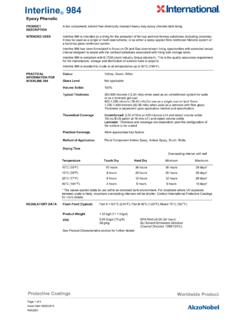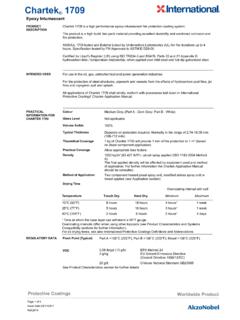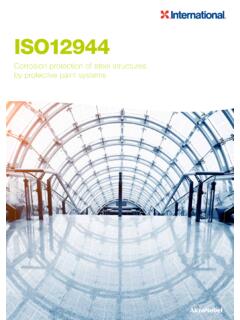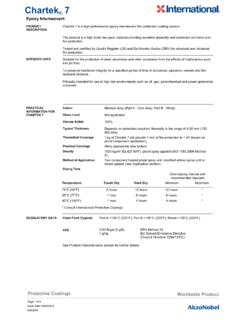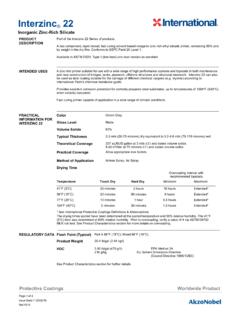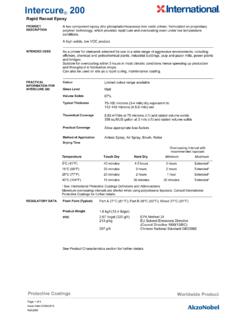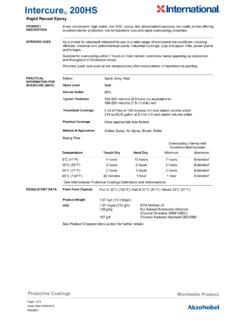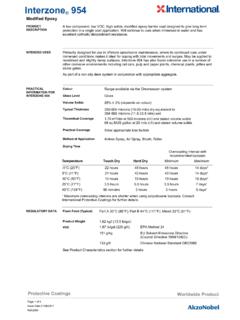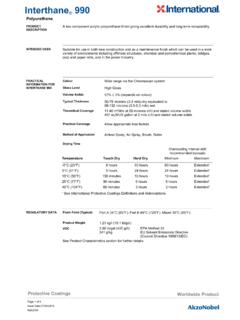Transcription of Epoxy - AkzoNobel
1 A two component Epoxy anti-corrosive primer pigmented with zinc phosphate. PRODUCT DESCRIPTIONFor use on properly prepared surfaces in both new construction situations and as an industrial maintenance primer for a wide range of anti-corrosive coatings systems for use in the offshore, petrochemical, chemical, pulp and paper and bridge industries. The fast drying and handling properties, together with extended overcoatability, make this an excellent primer for factory application prior to full system application on site. intergard 251 provides good abrasion resistance which minimises mechanical damage in transit between the factory and site. INTENDED USESBuff, Grey, Red Oxide Matt 63% 2%50-75 microns (2-3 mils) dry equivalent to79-119 microns ( mils) wet m /litre at 75 microns and stated volume solids337 gallon at 3 mils and stated volume solids Allow appropriate loss factors Air Spray, Airless Spray, Brush, Roller PRACTICAL INFORMATION FOR intergard 251 ColourGloss LevelVolume SolidsTypical ThicknessTheoretical CoveragePractical CoverageMethod of ApplicationDrying TimeTemperature Touch DryHard DryMinimumMaximum Maximum overcoating intervals are shorter when using polysiloxane topcoats.
2 Consult International Protective Coatings for further Interval withrecommended topcoats10 C (50 F) 2 hours7 hours7 hours12 months 15 C (59 F) 1 hour5 hours5 hours12 months 25 C (77 F) 45 minutes3 hours3 hours12 months 40 C (104 F) 30 minutes2 hours2 hours12 months Part A 24 C (75 F); Part B 27 C (81 F); Mixed 24 C (75 F) kg/l ( lb/gal) REGULATORY DATAF lash Point (Typical)Product WeightVOCSee Product Characteristics section for further lb/gal (390 g/lt) EPA Method 24293 g/kg EU Solvent Emissions Directive(Council Directive 1999/13/EC) intergard 251 EpoxyPage 1 of 4 Ref:2113 Issue Date:27/06/2017 Protective CoatingsWorldwide ProductIntergard 251 EpoxyAll surfaces to be coated should be clean, dry and free from contamination. Prior to paint application all surfaces should be assessed and treated in accordance with ISO 8504:2000.
3 Oil or grease should be removed in accordance with SSPC-SP1 solvent cleaning. Abrasive Blast Cleaning Abrasive blast clean to Sa2 (ISO 8501-1:2007) or SSPC-SP6. If oxidation has occurred between blasting and application of intergard 251, the surface should be reblasted to the specified visual standard. Surface defects revealed by the blast cleaning process should be ground, filled, or treated in the appropriate manner. Surface profile must be a minimum of 50 microns (2 mils). Shop Primed Steelwork Weld seams and damaged areas should be cleaned to a minimum St3 (ISO 8501-1:2007) or SSPC-SP3. Optimum performance will be achieved with blasting to Sa2 (ISO 8501-1:2007) or SSPC-SP6; where this is not practical, power tool preparation to SSPC-SP11 is recommended.
4 If the shop primer shows extensive or widely scattered breakdown overall sweep blasting may be necessary. SURFACE PREPARATIONM aterial is supplied in two containers as a unit. Always mix a complete unit in the proportions supplied. Once the unit has been mixed it must be used within the working pot life specified.(1) Agitate Base (Part A) with a power agitator.(2) Combine entire contents of Curing Agent (Part B) with Base(Part A) and mix thoroughly with power agitator. 4 part(s) : 1 part(s) by volume SuitableTypically 40-50 microns ( mils) can be achieved SuitableTypically 40-50 microns ( mils) can be achieved International GTA220(or International GTA415) International GTA822 or International GTA415 Do not allow material to remain in hoses, gun or spray equipment.
5 Thoroughly flush all equipment with International GTA822. Once units of paint have been mixed they should not be resealed and it is advised that after prolonged stoppages work recommences with freshly mixed units. Clean all equipment immediately after use with International GTA822. It is good working practice to periodically flush out spray equipment during the course of the working day. Frequency of cleaning will depend upon amount sprayed, temperature and elapsed time, including any delays. All surplus materials and empty containers should be disposed of in accordance with appropriate regional not thin more than allowed by local environmental legislation. RecommendedRecommendedGun DeVilbiss MBC or JGAAir Cap 704 or 765 Fluid Tip ETip Range mm (15-21 thou)Total output fluid pressure at spray tip not less than 155 kg/cm (2204 )APPLICATIONM ixingMix RatioWorking Pot LifeAirless SprayAir Spray(Pressure Pot)BrushRollerThinnerCleanerWork StoppagesClean Up10 C (50 F) 15 C (59 F) 25 C (77 F) 40 C (104 F) 10 hours8 hours6 hours3 hoursPage 2 of 4 intergard 251 EpoxyIntergard 251 is preferred for use with systems for chemical environments where zinc based materials can be subject to attack in both acidic and alkaline conditions.
6 The maximum overcoating interval will be dependent upon the integrity of the exposed film. A film of 75 microns (3 mils) dry film thickness will normally be overcoatable after 6-12 months exposure (depending upon the corrosivity of the environment) provided it is adequately cleaned and any areas of mechanical damage repaired. Over-application should be avoided as thick films will not be as good a substrate for topcoat adhesion after ageing as those at the specified thickness. When using as a blast holding primer avoid over-application as thick films may suffer from cohesive film splitting if subsequent coats are also over-applied. Over-application of intergard 251 will extend both the minimum overcoating periods and handling times, and may be detrimental to long term overcoating properties.
7 When applying intergard 251 by brush or roller, it may be necessary to apply multiple coats to achieve the total specified system dry film thickness. This product will not cure adequately below 5 C (41 F). For maximum performance, curing temperatures should be above 10 C (50 F). Surface temperature must always be a minimum of 3 C (5 F) above dew point. In common with all epoxies intergard 251 will chalk and discolour on exterior exposure. However, these phenomena are not detrimental to anti-corrosive performance. intergard 251 is not designed for continuous water immersion. Where a durable cosmetic finish with good gloss and colour retention is required overcoat with recommended topcoats. Note: VOC values are typical and are provided for guidance purpose only.
8 These may be subject to variation depending on factors such as differences in colour and normal manufacturing tolerances. Low molecular weight reactive additives, which will form part of the film during normal ambient cure conditions, will also affect VOC values determined using EPA Method 24. PRODUCT CHARACTERISTICSI ntergard 251 is designed for application to correctly prepared steel. However, it is also possible to apply over approved prefabrication primers. Further details of these can be obtained from International Protective Coatings. The following primers are recommended for intergard 251: Interzinc 22 * (mist coat or tie coat may be required)Interzinc 52 Interzinc 2280 * (mist coat or tie coat may be required)InterH2O 280 The following topcoats are recommended for intergard 251: Intercure 200HS intergard 345 Intercure 420 intergard 475 HSInterfine 629HS intergard 740 Interfine 878 Interseal 670 HSInterfine 979 Interthane 870 intergard 251 Interthane 990 Alternative topcoats are also available, consult International Protective Coatings.
9 See relevant product data sheet for details. SYSTEMS COMPATIBILITYPage 3 of 4 intergard 251 EpoxyRect TopRect BottomDetail TopFurther information regarding industry standards, terms and abbreviations used in this data sheet can be found in the following documents available at : Definitions & Abbreviations Surface Preparation Paint Application Theoretical & Practical Coverage Individual copies of these information sections are available upon request. ADDITIONAL INFORMATIONThis product is intended for use only by professional applicators in industrial situations in accordance with the advice given on this sheet, the Material Safety Data Sheet and thecontainer(s), and should not be used without reference to the Material Safety Data Sheet (MSDS) which International Protective Coatings has provided to its customers.
10 All work involving the application and use of this product should be performed in compliance with all relevant national, Health, Safety & Environmental standards and regulations. In the event welding or flame cutting is performed on metal coated with this product, dust and fumes will be emitted which will require the use of appropriate personal protective equipment and adequate local exhaust ventilation. If in doubt regarding the suitability of use of this product, consult International Protective Coatings for further advice. SAFETY PRECAUTIONSPACK SIZEUnit SizePart APart BVolPackVolPackFor availability of other pack sizes, contact International Protective litre16 litre20 litre4 litre5 litre5 US gal4 US gal5 US gal1 US gal1 US galSHIPPING WEIGHT(TYPICAL)Unit SizePart APart B20 litre26 kg5 US lbShelf Life12 months minimum at 25 C (77 F).
